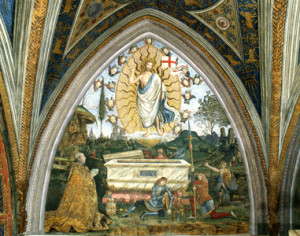by Carol Glatz
VATICAN CITY (CNS) – A little bit of spring cleaning or a much needed renovation can turn up the most unexpected things – especially if you’re sprucing up or digging through the Vatican.
Home of hundreds of thousands of artifacts, archived documents, ornate frescoes, plaster niches and underground tombs, it can be heavenly for a treasure hunt.
The latest precious find came after restorers tackled the Borgia Apartments, which were decorated by the Renaissance master, Bernardino di Betto, better known as Pintoricchio.
The Vatican Museums’ director thinks what restorers found under soot and successive coats of color are the very first painted depictions of Native Americans.
Antonio Paolucci told the Vatican newspaper the recently unveiled portion of the fresco shows a cluster of “nude men, ornate with feathers, in the act of what seems to be dancing.”
The mysterious men appear in the background under a Risen Christ in Pintoricchio’s fresco of “The Resurrection” in the Room of the Mysteries of Faith in the Borgia Apartments.
Paolucci said it wasn’t inconceivable that the Renaissance painter included the then-recently discovered inhabitants of the New World.
Spanish Cardinal Rodrigo Borgia, whose country of origin was funding the voyages, was elected Pope Alexander VI in 1492, just a month before Christopher Columbus sighted land in the Americas.
“The Borgia pope was interested in the New World,” Paolucci said. The process of decorating the apartments finished in 1494, and it is unlikely the pope “was in the dark about what Columbus saw when he arrived to the ends of the earth.”
Fresco restoration seems to be a lot like unwrapping a grab-bag gift: You never know what you’ll find by peeling away layers of centuries-old grime, water damage or botched painting repairs.
Experts working on the Vatican’s catacombs of St. Thecla uncovered what’s believed to be the oldest known depiction of St. Paul and announced the find just a week before the apostle’s feast day on the tail end of the Pauline year in 2009.

Breathtaking Portrait
Blasting off limestone encrusting the painted ceiling with a laser revealed a fourth-century portrait that was so detailed and stunning “it took the restorers’ breath away,” the Vatican newspaper had reported.
The image of a bald man with a stern expression, a high forehead, large eyes, distinctive nose and a dark tapered beard matched images of St. Paul from later centuries, experts said.
Continued cleanings in the burial chamber in 2010 exposed what experts claimed were the oldest existing paintings of SS. Peter, Paul, Andrew and John.
If just scrubbing and scraping can lead to surprises, imagine what happens when advanced technology lets you snoop in places that had been inaccessible for centuries.
Archeologists had always been curious to find out what was inside an enormous marble sarcophagus – the presumed tomb of St. Paul, in Rome’s Basilica of St. Paul Outside the Walls.
Because part of the sarcophagus is wedged beneath building material and opening it would have meant demolishing the papal altar above it, it had never been opened in the 20 or 19 centuries it was there, Cardinal Andrea Cordero Lanza di Montezemolo, the basilica’s former archpriest, said in 2009.
Vatican engineers tried using an X-ray, but the 10-inch-thick marble was impenetrable.
